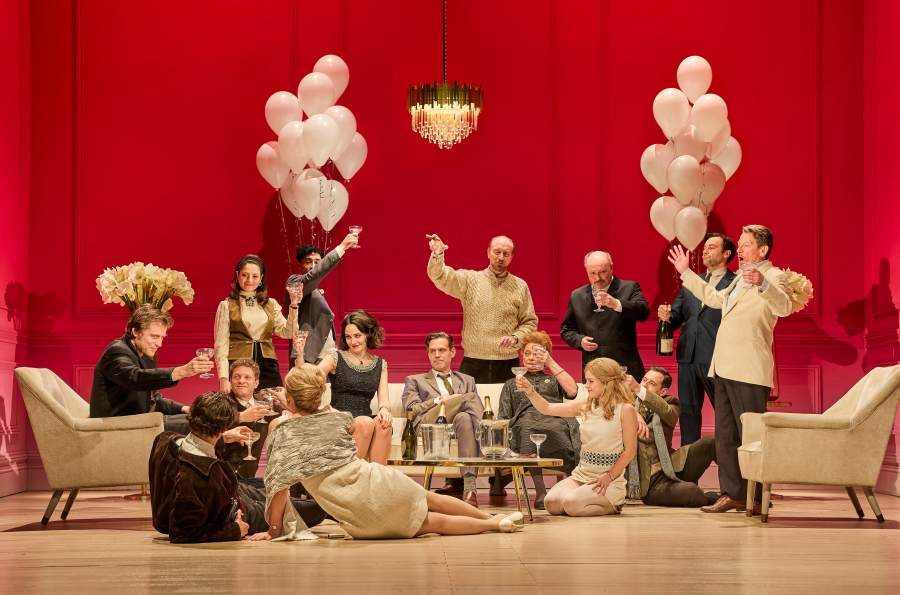

On the recent three day MLK weekend, I took a busman’s holiday, flew to London and attended several shows. The first one I saw was The Motive and the Cue, presented by the National Theatre. The plot is based upon an actual event, the production of Hamlet in New York City from April 9 to August 8,1964, starring Richard Burton and directed by Sir John Gielgud. The play was a financial success and was the longest run of Hamlet in Broadway history, running for 137 performances. A renowned Shakespearean actor himself when younger, Sir. John Gieldgud had turned to directing, and this production ensured his successful career as a director.
Written by Jack Thorne (Harry Potter and the Cursed Child,) The Motive and the Cue combines mounting the production of Hamlet with the conflict between Gielgud and Burton. At the time, Burton was in his heyday of popularity and the public was fascinated by him, especially with his tempestuous relationship to the gorgeous Elizabeth Taylor (Tuppence Middleton.)
The engrossing part of the play is how Thorne intersperses lines from Hamlet with the dialogue of the actors. The rehearsal time is 28 days and each day is flashed on the curtain between scenes along with a quote from the play. Under the superb direction of the award-winning Sam Mendes, the show is well-staged. The Motive and the Cue begins with a table read and then later the actors rehearse individual scenes. Some of the cast members, well-known actors like Hume Cronyn (well-played by Allan Corduner) actually took their small roles, specifically to be directed by Gielgud.
In theory, Gielgud, as the director, steers and guides the play, yet it is clear that Burton (played with appropriate arrogance and cockiness by Johnny Flynn) is in charge. Rehearsals begin when he arrives. He disagrees with aspects of Gielgud’s direction and it’s clear that the elder actor is there only with Burton’s endorsement. So Gielgud is more deferential than one would expect. Because of his gentlemanly demeanor and tone, as well as the skill of actor Mark Gatiss, the audience roots for him. Gatiss is quiet, regal and respectful. In contrast, Burton is a bombastic, imperious figure who commands everyone’s attention. Because Burton didn't like wearing period clothing, Gielgud came up with his own concept, a production performed in a “rehearsal” setting. The actors appeared to be wearing their own street clothing.
The audience is privy to the inner workings of a Shakespearean play. Ironically the actual 1964 production was successful, despite the turmoil and uneven reviews for Burton. Interestingly, the play fails to mention that fact.
The performances in The Motive and the Cue are good, and Gatiss is exceptionally effective and you don’t have to know Gielgud to appreciate him. As the play goes on, Flynn gets better and more believable.
The title of the play comes from lines from Hamlet when Hamlet is still debating whether to avenge his father’s death. He observes the behavior of The Player King in the play-within-a-play, wondering “What would he do,/ Had he the motive and the cue for passion/ That I have?” Burton seeks to understand Hamlet’s motivation when Gielgud gives him a new interpretation. This moment appears to be the turning point between Burton and Gielgud.
What Thorne does is create several scenes to add the actors’ own “motive and cue.” Gielgud was a homosexual, a fact that was hidden at the time. Yet the playwright includes it in the story by adding a scene with Gielgud and a young man he hires. There’s no physical interaction, save a firm embrace. There seems to be little point to that scene since it adds little to the storyline or the relationship of Burton and Gielgud.
In another contrived scene, Elizabeth Taylor invites Gielgud for breakfast, ostensibly to “broker peace” between the two. Thorne uses it as a chance to give some of Burton’s background to explain why he is the way he is. His mother had died and his father was a drunkard, leaving his older sister to raise him. So Burton created his own story. In fact, except to add some glamor, the character of Taylor adds little to the heart of the story since she isn’t the reason the two men are at odds. Knowing that Burton has just married Taylor and they have a passionate sexual relationship doesn’t add much to the theme of the play.
Where The Motive and the Cue is most effective is in showing some of what really happens behind the scenes of a play. The audience feels like it is being included as the production is coming together and that’s really exciting.
So would this play be successful if transferred to Broadway? It appeals to specific subsets of the theater audience. Those of a certain age who know and /or were fans of Burton, Taylor and Gielgud. As well as Shakespeare fans or serious theater aficionados. I enjoyed the play a great deal because it checked off many of my theater boxes, but I’m not sure it would hold much appeal to a general audience.
Noël Coward Theatre
85-88 St Martin’s Lane
London, WC2N 4AP